The lessons of Uzbekistan’s lost sea
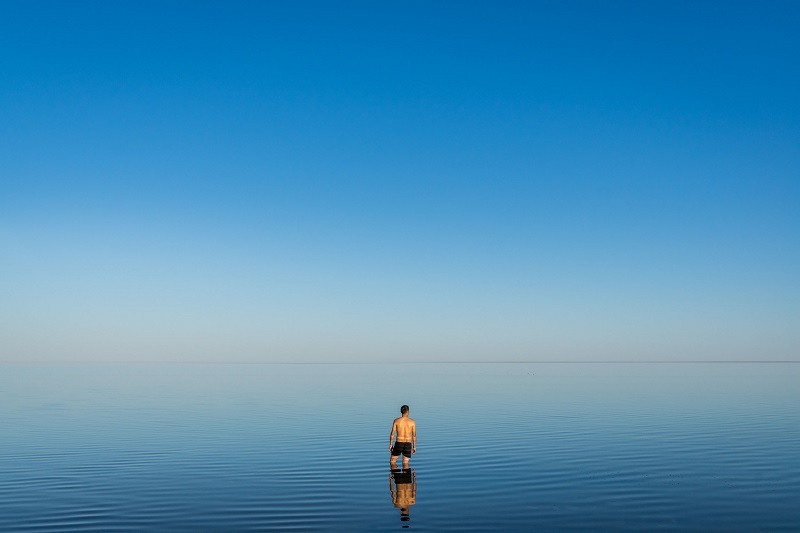
Guide Kutlimurat Maksetov walks out into what remains of Uzbekistan’s portion of the Aral Sea.
17:55 JST, August 30, 2022
Not for the first time, out on the salt pan, my mind had turned to death. It must have been 140 degrees on the crystalline surface of Barsa-Kelmes. The very air had a poisonous tang. How long could a person last out here? A week? A day? I wasn’t sure I’d endure an hour. I could barely reconcile this with my other observation, which was that the salt was beautiful, like a sea of gemstones stretching to the horizon.
A shape caught my eye amid the glitter: a small butterfly encased in the salt. It lay on its side, the mottled brown wings sealed together. Crystals had started to progress over its head and thorax. I could see that the creature had died with its proboscis fully extended, searching in vain for some sustenance as the salt had sucked the moisture from its exoskeleton.
I admit that there were points, amid the ferocious heat, the spine-jangling drives, the inescapable context of economic collapse, environmental decay and animal extinction, when I questioned what on Earth had possessed me to come to the Aral Sea. The sea, which is actually classified as a lake, was more a memory than a body of water now.
It began, like so many tragedies, with hubris. From the 1920s onward, as part of a plan to collectivize agriculture, the Soviet Union determined that a vast swath of its Central Asian vassals would be given over to cotton. Inefficient irrigation canals, dug by hand, redirected water from the Amu Darya and Syr Darya – two rivers that originated in the high glaciers of the Tien Shan Mountains – to feed the thirsty monoculture that soon covered millions of hectares of previously uncultivated land.
Since the start of the current Holocene epoch, approximately 11,700 years ago, the rivers had sustained the Aral’s delicate equilibrium. Covering 26,000 square miles, straddling the border of modern Kazakhstan and Karakalpakstan, Uzbekistan’s autonomous western republic, the lake was a pearl in the arid steppeland, the fourth-largest inland body of water in the world. From the mid-1800s, fishing ports thrived on its bounty.
But in the 1960s, the diversion of yet more of the Amu Darya’s flow into the new Karakum Canal precipitated a tipping point. The Aral’s waterline started to recede. The water became brackish, then saline, then anoxic – inimical to fish life, which died away almost overnight.
During the Soviet era, when foreigners were prohibited from entering Karakalpakstan, news of the Aral’s plight was spilled by satellite, as images from above showed its shoreline shrinking from the edges, then splitting into pieces. For most of us, this was how the crisis was viewed – from the abstraction of space, a mutation of the map.
On the ground, a human disaster was unfolding. As the lake disappeared, so did its regulatory influence on the surrounding climate. Freezing winters gave way to searing summers. Winds mixed sodium chloride with freshly exposed carcinogenic particulates, which had leached into the land as a result of agricultural runoff and bioweapons testing, then carried the resulting noxious dust clouds into the atmosphere. By the 1980s, Karakalpakstan suffered from some of the worst cancer and infant mortality rates in the Soviet Union. Toxins from the Aral have been found in the bloodstream of Antarctic penguins.
In 2005, a dam built to contain the waters of the Syr Darya led to a partial recovery of Kazakhstan’s northern portion of the lake, while also sealing the south’s fate. In 2014, the lake’s eastern lobe vanished for the first time.
Today, Karakalpakstan’s share of the water has evaporated down to a western sliver. The land revealed by its recession has become the Aralkum, an anthropogenic desert, a cautionary parable. It is often cited as the worst man-made ecological catastrophe in history.
Since the collapse of the Soviet Union, a trickle of foreigners have found their way to Karakalpakstan, most of them drawn by the Igor Savitsky Museum, an unlikely trove of avant-garde Soviet art, in Nukus, the provincial capital. However, in recent years, more and more have continued north to see what’s left of the lake, and the land its diminution left behind.
What is the appeal of such a benighted destination? In “Notes From an Apocalypse,” the writer Mark O’Connell describes his journey to Pripyat, the scene of the Chernobyl nuclear accident, as an opportunity “to see the end of the world from the vantage point of its aftermath.” Like Chernobyl, the Aral region offers a chance to bear witness – in this case, to the kind of precipitous disaster that so many people fear now awaits more communities in the era of climate change. A similar scenario is playing out in Utah’s Great Salt Lake.
Dark tourism. Disaster tourism. Call it what you will. Karakalpakstan occupies a transitional space between a foreboding present and a potentially cataclysmic future. Which was why I wanted to go.
***
My first glimpse of what used to be the Aral Sea came at the top of a bluff, on the northern edge of Moynaq. In the Soviet era, Moynaq had been a fishing town of 30,000 souls, a settlement whose very existence depended on the lake. Most of the men worked in the boats. The women staffed the cannery, which never slept, producing 30 tons of product a day.
Below, at the leading edge of a vast wasteland, was its aftermath: a dozen boats, rusted umber, all that remained of the 100-strong fishing fleet, which had been dragged here from the spots where they were marooned as the sea ebbed away. Now they lay askew, propellers half-buried in sand.
Over the years, people had taken to scrawling chalk graffiti on the hulls and cabins. Messages of hope. Of thanks. Couples’ initials encircled by hearts. And so the ship graveyard, as it has come to be known, had become a palimpsest, new memories etched onto old. A handful of visitors circled the hulls, ran hands over the last flakes of paint, clambered onto the jagged decks to poke inside.
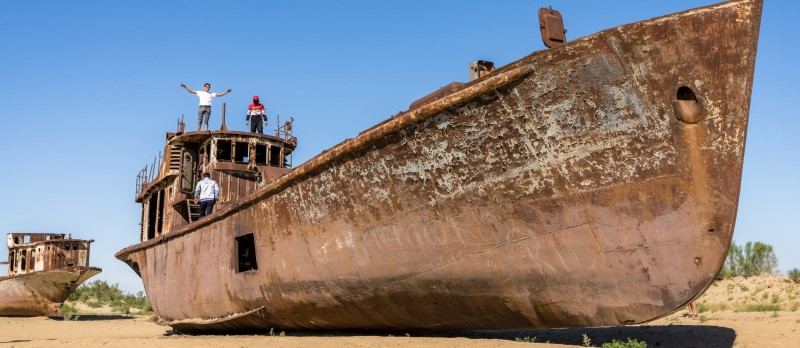
Visitors on an abandoned fishing boat in the “ship graveyard” in Moynaq, Uzbekistan, on what used to be the Aral Sea.
Ali Shadinov still had vivid memories of the years before the lake disappeared. It was, he said, a time of plenty: “There were so many fish, we used to throw the small ones away.”
In 1969, Shadinov was 18 years old, just starting out as a fisherman himself, when the older men began murmuring that something was wrong with the lake. It wasn’t the water level, not yet. It was the taste. The lake was getting saltier.
Now 70 years old, with an avuncular twinkle, Shadinov is one of the dwindling number of Moynaq residents who lived through this transformation. We met in Future Moynaq, a recently opened library-cum-learning-center. Its wallpaper showed a verdant forest scene, which felt simultaneously pleasant and cruelly ironic, given the desiccated environs of the town outside.
Within three years, the old hands’ prophecies had come to pass. As the lake withdrew from Moynaq’s waterfront, the townsfolk dug a channel so that the boats could still access the water. But before long, the deep-hulled vessels, named after Marxist heroes like Engels and Marx, were land-bound, useless in the sand. Ali and his father gave up pursuing the lake in 1977.
Another elder, Bibikhan Utambetova, took up the story. The worst crisis years were around the turn of the millennium, she told me. That was when Moynaq ran out of fresh water, which had to be trucked in from upriver. By now, the Kazakh and Russian friends she’d grown up with had headed back across their respective borders. Any delusions that the lake might return had given way to despair.
In 2002, she was appointed head of Moynaq’s women’s committee, where she agitated for government relief. Since then, Moynaq has undergone a slow reinvention. The administration in Tashkent, the Uzbek capital, increased investment. Part of the canning factory cranked back to life to process artemia, a tiny brine shrimp that has proliferated in the Aral’s saline water and is coveted in China for use in medicine and cosmetics. The airport, closed for 30 years, was reinaugurated in 2020. “Moynaq has learned to hope again,” Utambetova said.
Back up on the bluff, this hope was manifesting in some unexpected ways. Our visit had coincided with the annual Moynaq Rally, and the drivers had gathered with their souped-up vehicles in the parking lot ahead of the following day’s race to rev engines and talk about gaskets or suspension or whatever.
Across the lot from the squat cylinder of the Aral Sea Museum, a black-and-white mural of fish skeletons and aquatic spirits wound around the old lighthouse, which now housed a cafe. In front of it was an archway of hammered metal that brought to mind the scrappy, dystopian aesthetic of Mad Max. A row of punched-out capitals read “HERE | NOW” and, in Cyrillic, the word “СТИХИЯ,” or “Sithia,” meaning “Force of Nature,” the name of a festival that was held here in May. Two thousand people had come to party, make art and listen to electronic dance music with the boats as a backdrop. Faced with a tableau of the apocalypse, one human response was to dance.
***
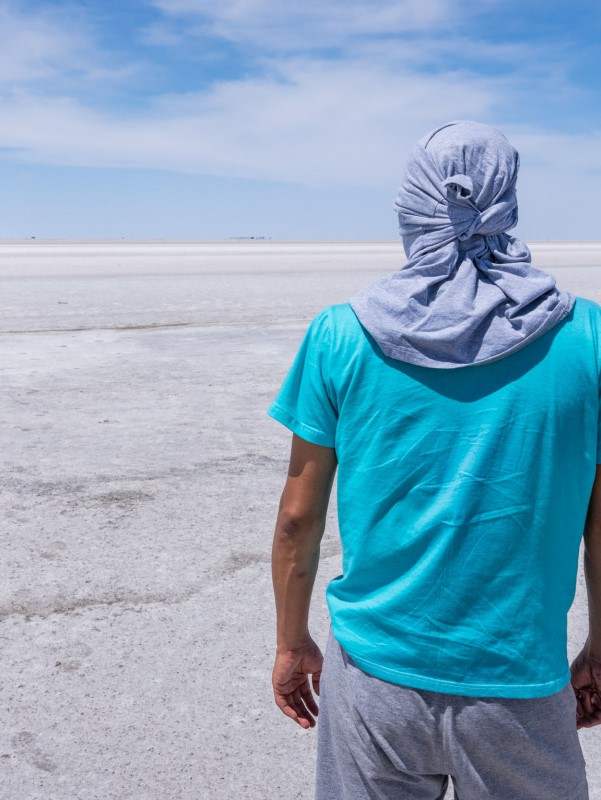
Guide Kutlimurat Maksetov on the salt pan of Barsa-Kelmes in Uzbekistan, to the southwest of the Aral Sea’s former lakeshore.
It was in a more sober mood that I found myself jouncing along the corrugated floor of the Aralkum in early June. I was traveling with my friend and photographer Marcus Westberg, and with Kutlimurat Maksetov, a young cultural anthropologist and local guide from Nukus who went by Kolya. Maqsud, an older man with limited English who seemed to know everyone from here to the Kazakh border, had the wheel. A talisman the shape of a camel dangled from his rearview mirror.
On every side: a wasteland so flat it felt as though you could see the curvature of the Earth. The only verticality was the gas fields, of which there were several, prompting a jarring realization that the climatic catastrophe of the Aral had unveiled an opportunity to take more carbon from the ground. Drilling scaffolds formed isosceles triangles on the horizon. Flare stacks trailed pennants of flame.
The former lake bed, when we got out to stretch our legs, had baked into a crust that crumbled underfoot. Closer inspection revealed that it was strewn with clamshells, bleached chalk-white, that once propped up the Aral’s obliterated food chain.
The most pressing concern, now that the water had retreated dozens of miles to the north, was the dust. As we drove, Kolya produced a tablet and showed me photos of the aftermath of a huge dust storm that had swept across Karakalpakstan in May 2018. A hundred miles south, in Nukus, the cars and buildings had been caked in a salty residue. “Everyone had to stay inside for three days,” Kolya said. “Most of the plants in the city died.”
The authorities were putting their faith in an unusual solution: saxaul, the shrub that we could see proliferating across the sand. The hope was that the fibrous bushes would stabilize the skin of the desert and “catch” the salt-laden dust particles before they could get airborne. In the wake of the 2018 storm, a thousand tractors were deployed to seed-drill saxaul across nearly 2 million acres of lake floor. Time would tell whether it would prove successful. Today, at least, the sky was crystal clear.
The remnants of the Aral appeared around half an hour after we climbed onto the Ustyurt Plateau, the vast rock shelf that formerly delineated its western edge. It materialized at first as a shock of color on the horizon, then later resolved into a disk of topaz blue. Having read so much about the lake’s ruin, its perfection, against the parched land, was startling. It would exert a mesmeric hold on us for as long as we were in its vicinity.
It was midafternoon by the time we arrived at the yurt camp where we would be staying for the next couple of days. Occupying a broad shelf, around halfway down the escarpment, it consisted of 16 comfortable yurts arranged around a communal space. Off to one side were toilets, showers and a simple bungalow, where the caretakers, Abat Awesbaev and Zoya Palimbetova, lived through the summer season with their three young children. The camp was clean and well kept, salubrious even. A pair of chaykhana tables, seating platforms often found in Uzbek teahouses, stood at the front of a sandy shelf overlooking the lakeshore.
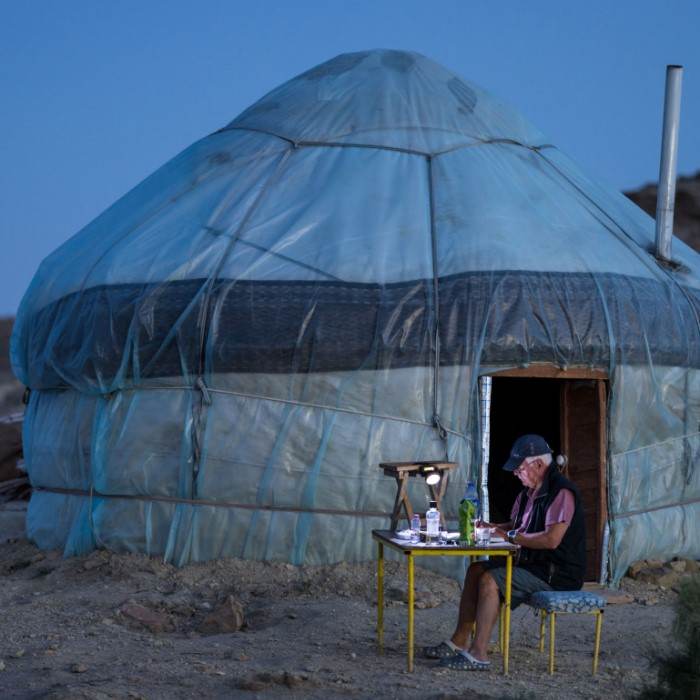
A tourist from Austria sits outside his yurt to update his journal as evening closes in at the Aral Sea yurt camp.
Opened in 2017, the yurt camp – indeed, the very concept of Aral Sea tourism – was the brainchild of Tazabay Uteuliev. In 2005, he was working in a hotel in Nukus when the Italian ambassador approached to ask whether he could arrange a trip to see the lakeshore. Uteuliev rented an old Russian jeep and drove the ambassador and his family across the Aralkum.
Although Uteuliev’s parents lived in Moynaq, it was the first time he’d ever laid eyes on the Aral. “I thought we’d lost the lake forever,” he told me. “But then I saw the blue water, the beauty of the canyons. I realized this was a place that people would want to see.” For the first few years, his tours carried everything with them; guests stayed in tents and cooked evening meals on open fires. The yurt camp was built in 2017 to cope with the demand. Now his company, Aral Sea Discovery, had a fleet of 11 Toyota Land Cruisers and bookings were picking up to pre-pandemic levels.
***
Daily activity at the camp was dictated by the sun. In the early afternoon, when the heat was at its most ferocious, everyone retreated to slivers of shade to take a siesta or just sit very still. The only interruption was the incongruous chime of the satellite phone, which rang regularly, notifying Abat of comings and goings or how much plov (Uzbekistan’s national dish of rice and lamb) to cook for the evening meal.
Mornings and early evenings were for exploring the plateau. At the rim, where the gypsum shelved down toward the distant lake, areas of the cliff ruptured into canyon systems. In places, it had eroded into fins and pinnacles. In others, it had calved iceberg-like from the escarpment, splintering into house-size cubes. The sedimentary layers banding the rock were a reminder that the Aral’s retreat is a small-scale echo of a more titanic draining. This area, like much of Eurasia, was once submerged beneath the ancient Tethys Sea.
In the shelter of the cliffs were miniature ecosystems. Dappled butterflies danced around allium and artemisia, the latter of which filled the gullies with a scent like lemonade. I lingered here, keen to absorb these signs of vitality. So many of the other scenes we experienced up on the plateau had the opposite vibe.
The salt pan of Barsa-Kelmes, with its dead insects entombed by its sheet of crystal, wasn’t the only memento mori we discovered up here. Ancient cemeteries, final resting places of nomads who plied these edge lands during the heyday of the Silk Road, were a regular sight on the plain. The graves were marked by piles of rock and standing stones upon which were etched recurring symbols – a lollipop, a stylized twig – denoting the clan of the person buried therein. Exactly who or what each symbol signified Kolya didn’t know.
Elsewhere, the plateau was utterly barren. Five years ago, Kolya told me, a French group had opted to drive across the Ustyurt without a guide. They had GPS but nonetheless managed to get stranded up on the plateau. A search party found them a week later, deliriously eating lipstick and drinking perfume.
When we reached the derelict village of Urga, Jalgas Nurullaev was sitting outside a tin-roofed cabin, smoking the stub of a cigarette. He showed no surprise at our arrival, even though he was the only person for dozens of miles in any direction. Tourists sometimes came here, to the dead village, he said, and he always offered to take them for boat rides on Sudochie Lake, the small body of water separate from the Aral that we had seen as we rolled down the hill. He could take us, too, if we liked.

Jalgas Nurullaev, a fisherman from Kungirot, Uzbekistan, in the abandoned village of Urga to prepare for a short fishing window on Sudochie Lake, a small body of water separate from the Aral.
Nurullaev – diminutive, with a weathered face and cropped hair – was here to prepare for a short fishing window. In a week or so, he and four friends would take to the lake in shallow skiffs to hunt for sazan and snakehead, which they would sell back home in Kungirot. Not that there were many fish. Not that there was much lake. The Sudochie was drying up, turning saline, Nurullaev said. Every year the seasonal haul diminished. All around the lake’s periphery, we could see that the reeds were turning brown.
It was no kind of shock to discover that water scarcity had spelled doom for Urga. It had once been home to 200 families, mostly Russians and Poles, but the community collapsed when a pipeline project to bring in potable water failed in the 1950s. The settlement they left behind had all the accidental poignancy of hasty abandonment. The centerpiece was the old smokehouse, a large, roofless block with a churchlike facade, its interior piled with detritus old and new. All that remained of the reed houses where Urga’s residents used to live were a few combs of stems projecting from the sand. Still more wretched was the graveyard we found at the top of the hill, a patch of coarse, anonymous wooden crosses, several of which had fallen over.
During my time in Karakalpakstan, I had been reading “Islands of Abandonment” by Cal Flyn. A bestseller in my native United Kingdom and a book of rare pathos, it described nature’s tendency to reclaim areas that humans had used, abused and left behind. Places rendered uninhabitable because of unexploded ordnance or chemical contamination – or even, as in the case of Chernobyl, radioactive fallout – were now running wild.
I’d hoped that this trip might offer some glimmers of that optimism, but the truth was that the Aral didn’t quite fit the mold. Here, the resilience of nature had failed to fill the gap. Conservationists were working to turn the Aralkum into a stronghold for saiga antelope. Flamingoes were flocking here to feast on the shrimp. But no amount of evolutionary ingenuity could replace the biomass of the Aral. Instead, this region was analogous to Flyn’s chilling coda, the Salton Sea in California: “An augury of the end of the world, the dawning of the age of dust.”
***
Perhaps it was the stories, the isolation, the otherworldly sensation of the friable ground. But I had read so much about the catastrophe of the lake’s withdrawal that it had become impossible to pass through the Aralkum without feeling haunted.
On the second afternoon, we went right down to the shore. Everything about the littoral seemed deceitful, untrustworthy. The beach, if you could call it that, had the jagged texture of dead coral. The water’s edge was frothed into a pink spume – evidence, Kolya speculated, that the artemia were spawning. Somehow the thought of sharing a swim with a billion larval crustaceans did little to alleviate my unease.
When I finally convinced myself to get in the water, the ground gave way, each footstep sinking several inches into a sucking, silken clay. The only solution was to crawl out on all fours and then, when you got around six inches clearance, flop bodily onto your back, trusting that the buoyancy of the tepid, salty water would keep you above the silt.
Even when I was adrift, I couldn’t take my mind off the quicksand below. All I kept thinking was: I wonder if there are areas of the lake floor that could swallow a person whole? And: What happened to the bodies of all the fish? It felt like dipping into a colossal grave. Later, I hung my swimming trunks over the door of our yurt, where they dried out in minutes, assuming the texture and rigidity of cardboard.
That evening the yurt camp was at capacity. As the temperature dropped, around two dozen guests, newly reanimated, convened at the promontory to watch the last interactions of water and sky.
Throughout the day I had been noting down the shifting moods of the lake. At dawn the sun rose directly over the dregs of the Aral, which blazed orange momentarily, then faded to a sheet of white gauze. By 11 a.m., the water had deepened into that complex shade of electric blue. In the midafternoon, there had been an hour when the breeze fell away to nothing. The surface of the lake went mirror-still, and it merged with the sky so that it became impossible to discern where water ended and atmosphere began. Now, we watched the water turn opalescent, then pick up the colors of the sunset to turn the hue and opacity of rose quartz.
It was a picture, certainly, but also irreducibly sad. Only by seeing what remained of the water was it possible to fully appreciate the tragedy of its absence – how awful its retreat must have felt to those habituated to waking up to it every morning.
Was this why people came here? To marinate in the melancholy of loss? Among those watching the sunset, plenty seemed to have more anodyne reasons. A Danish photojournalist was researching a book about the water crisis of the Amu Darya. An Austrian man, jocular as Santa, had guided some tour groups through Uzbekistan in the 1990s, and this was the one place he didn’t see. A young Russian couple had come here since “we aren’t welcome anywhere in Europe because of the war.”
For my part, I suspected that these were cover stories, concealing voyeuristic impulses that were more ignoble. To some extent, I knew, disaster tourism was really about vainglory, a desire to feel, as O’Connell puts it, “the transgressive thrill of our own daring in coming here.”
But the more time I spent in this accursed landscape, the more certain I became that there were other, deeper emotions at play, too. Modern places of abandonment or catastrophe, it occurred to me that evening, were affecting primarily for their immediacy. The ambient entropy, which manifested here in the chaotic climate, the shriveling lake, the junk of human settlements laid waste, felt like the ultimate rebuke to our myopia.
That the Aral Sea represents an advanced stage on a continuum along which the whole planet is hurtling – hotter, water-deprived, despoiled – merely drove the point home. It left you with the sense that, for all our genius, we enjoy a habitable planet by the grace of such fragile providence. Actions, consequences. What more evidence do we need?
***
Against great odds, Karakalpakstan is trying to move on. A few months before our visit, the authorities in Moynaq had removed some of the last relics of the Soviet era, chipping off public mosaics that celebrated the town’s maritime past. The death knell that had sounded as the Aral began its long retreat was now fading away. In time, the Aralkum would evolve from a disaster zone to a memorial, and the sea itself would be all but gone. “I expect we can do this for the next 10, maybe 15 years,” Tazabay Uteuliev said. “After that, I guess we will find something else to do.” (Meanwhile, Karakalpakstan has more immediate concerns. Three weeks after I left the region, large protests in Nukus over government plans to dilute the province’s autonomy resulted in deadly clashes between protesters and police. At the time of writing, the situation is reported to have stabilized.)
The morning after we returned to Nukus, Maqsud drove us south to the ruins of ancient Khorezm, a kingdom that thrived for centuries along the once fertile oases of the Amu Darya delta. We were all alone at Chilpik Dakhma, a rotunda on a lonely outcrop, encircled by heavily eroded earthen walls. In its pre-Islamic period, when Khorezm was a cradle of Zoroastrianism, this was a place for “sky burial”; a boulder at its center marked the spot where people would lay down their dead to be picked clean by carrion birds. But one day in the early 13th century, the local population might have used it for another purpose – hiding here, in a state of terror, as a great dust cloud in the distance betrayed the approach of Genghis Khan’s ravening army.
Disaster can arrive in many guises, I thought, as the sun climbed over the dun lowlands. It was 9 a.m., the heat already an intolerable pulse. In the south, toward the Amu Darya basin, shocks of green marked the fields where the season’s early sprouts of cotton were unfurling. After days spent pondering the wreckage of the present, Chilpik’s forsaken clay seemed less like an artifact of distant events, more an echo. It felt like a warning.
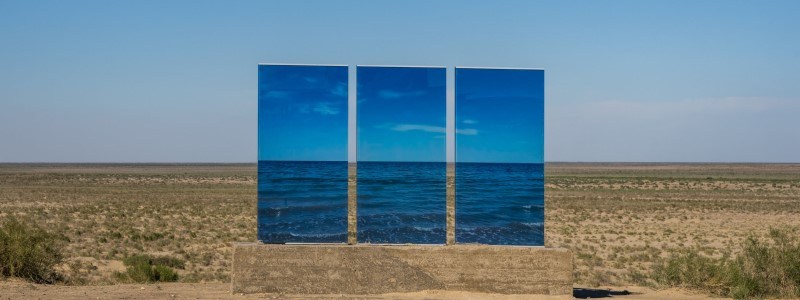
A triptych, erected on the northern outskirts of Moynaq, Uzbekistan, during the recent Sithia Festival, reconjures the former extent of the Aral Sea’s water.
Henry Wismayer
Henry Wismayer is a writer in London and a regular contributor to The Washington Post’s travel section.





